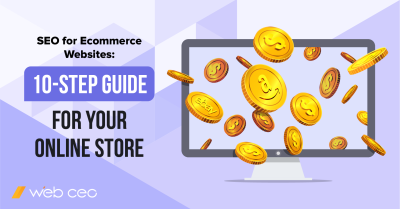
If you run an online business, you know that getting customers to your site is essential for building your brand, growing the business and increasing profits.
Search engine optimization (SEO) is an important component in maximizing your online presence and achieving those goals. SEO is defined as a process that increases the visibility of your website in search engine results pages without paying for it. This is also known as increasing visibility in “organic” or natural searches, as opposed to paid or native advertising.
If your site appears more often in organic searches, it follows that potential customers will click on that link, visit your page, and hopefully be converted to paying customers. Being successful at SEO means understanding how search engines work, as well as knowing what people are searching for, such as keywords used or questions asked.
There are lots of resources available to business-to-consumer (B2C) sites, which are businesses that target consumers as the end-users of their products or services.
But what about a business-to-business (B2B) model, where the end-user is another business? If your eCommerce site targets other businesses, SEO is important to you too, but there are some key tactics specific to your model that you will need to consider.
This SEO beginner’s guide for B2B companies will help you maximize your search engine results, increase traffic to your website and convert that traffic into customers.
Why SEO Matters for B2B
It’s true that the B2B environment is different than B2C, for a variety of reasons:
- More complex products and services – sales may not be closed online.
- A different buying process – it’s not as simple as a customer choosing the color and size of a shirt and clicking “BUY.”
- Longer buying cycle – it may take weeks or months for the decision to be made.
- Difference in the size of the market and target market – you aren’t targeting the entire Internet of consumers.
- Unique language – depending on your business, the jargon of the industry will impact your web copy.
This may lead you to believe that more traditional marketing is enough. You may think your sales force, channel partnerships, or word of mouth are sufficient marketing initiatives.
However, the fact remains that SEO is important. The decision-makers in a B2B environment still use web search. This happens when they are first looking for a product or service, prior to connecting with a sales person. They’ll be looking for the top results in their search.
It also happens after a sales pitch, word of mouth or channel connection is made. They will use the web to do further research on your company – and the competitors they are also looking at.
Therefore, your search strategy has to serve two purposes:
1. To increase organic traffic to your website.
2. To support your other marketing efforts with meaningful content that decision-makers will find in their due diligence phase.
That’s different than a B2C environment, where comments in forums, generating backlinks, or creating large volumes of content may be enough.
So let’s look at seven B2B SEO strategies to accomplish your business goals.
1. Have a High-Quality Website
Before driving traffic to your website, it’s essential to make sure the site itself is high quality. Look at it from a customer’s perspective, to make sure the user experience is top notch. Ensure customers will get what they need when they arrive at the site.
Since this article is focused on SEO, we won’t spend too much time on actual tactics for a better B2B website user experience. But here are a few things to consider:
- Incorporate quality design that highlights your company’s brand and image.
- Ensure the writing is high quality.
- Understand your target audience and build the website to serve them.
- Ensure the navigation is user-friendly, so users can find what they’re looking for.
- Keep your site free from errors by running timely website audits.
Make sure you spend enough time making your website great so you won’t be driving too many potential customers to it as a sub-par site.
2. Be Mobile-Friendly
While on the topic of user experience, be sure that your website is optimized for mobile.
In the past, we may have pictured a corporate decision maker behind a desk at the office, working on a desktop computer to do online research. That’s changing. Decision makers are younger, more likely to do work away from the office, and – like everyone else – more likely to use mobile devices for everything.
This means you need to make sure that your site is mobile-friendly. Here are a few tips to consider:
1. Make your landing page mobile-friendly. If you’re promoting a recent research report, for instance, make that landing page and the email sign-up form mobile friendly.
2. Make your blog mobile-friendly. We will discuss thought leadership in detail below, but if one of the tactics you choose is a regular blog post, make sure it’s mobile-friendly. You don’t want to drive customers to a blog, only to have them arrive via their mobile device and not be able to read it.
3. Consider making your site responsive. This means it’s coded to adapt to the viewer’s screen, whether it’s a desktop, a tablet, or any of a variety of smart phones. This is different than having a mobile site, which is a copy of your site slimmed down for mobile. Responsive sites are proving more user friendly and increasing search results from mobile.
4. Consider mobile when doing keyword research. We will expand on keyword research below, but when doing your research, consider how people do searches with mobile devices. They are using personal assistants like Siri or Alexa, and framing searches as full sentence questions.
Keep your B2B site optimized for mobile devices at all times. Test it now to see if it needs improvement.
3. Focus Your Content on Generating Leads
Let’s look at the content that will support your B2B SEO efforts. Particularly if you have complex or expensive products and services, you can’t expect decision-makers to complete sales online, at least as a first-time customer. Instead, when they come to your site at the start of their decision-making process, you will need to treat them like you would any other sales lead.
It’s important for your web content, therefore, to have all the details about your products and services, and plenty of ways to gather more information.
Include ways to contact a product specialist or salesperson for more details. Maybe it’s possible to order a sample or a test run of a product. Mention all those options and make it easy for the customer to contact your company, with phone numbers displayed prominently, online forms, email address requests or even live chats.
Product and service descriptions need to be well written, with clear, explanatory content. The specifications and features need to be covered in detail, along with descriptions of how the product or service is used. You can even help potential customers understand your product by adding images or videos.
4. Find the Right Keywords
Keywords are important to B2B and B2C SEO, but in B2B, there are some additional considerations.
If your industry has its own language, including jargon or acronyms, it’s important to include those in your keyword implementation. However, don’t overdo it with jargon. Make sure the content is clear and understandable.
As well, don’t make the mistake of using your brand or product in place of keywords. Unless your brand is so well known that customers search using only the brand name, you will need to do keyword research, which will then feed into the quality content on your site.
Here are some ways to do keyword research:
1. Use your sales team, your customer service team, or even customers, to do research. Find out what questions are being asked by customers or potential customers, and what they’re searching for when they go online. Also find out how they found you.
2. Find out the area of your customers’ companies that the decision-makers are from – the IT department or the executive team, for instance. Targeting your market will help with content creation.
3. Find a tool that works for you, like WebCEO’s Keyword Research, to search for relevant keywords.
4. Use long-tail keywords, like complete phrases or questions that your customers may ask.
5. Create Quality Content Through Thought Leadership
Once you understand the keywords and the phrases that people use to get to your site, create quality content that will appear in those search engine results. There are a number of ways to do that, but one of the best is by becoming a thought leader.
This is important for both of the objectives of your B2B SEO strategy – increasing organic traffic and supporting your other sales channels. Decision makers doing due diligence will want to see that your company is a leader in the industry, and quality content in the form of thought leadership will do that.
One of the best ways to accomplish thought leadership is to develop a regular blog that answers the important questions of your industry. Remember to use WebCEO’s SEO Content Assistant to ensure your blog posts are optimized for the keywords you’ve identified. Be sure to post it to all the relevant sites in your market, whether that’s LinkedIn, Facebook or even a video on YouTube.
Use your blog as part of other marketing tactics, like email marketing. Send your blog out with a regular email to customers and potential customers.
Be sure that at least some of your content is long-form content, which are articles over 1500 words in length. Longform content that addresses your keywords will get your website noticed in search results.
Another tactic is to make public appearances at trade shows or other venues, and video those for use on your website, YouTube, Vimeo, Daily Motion and other platforms.
6. Become an Expert in Your Industry
A quality blog produced on a regular basis will go a long way toward making you the go-to company in your industry. Another way to drive that point home is by producing original research.
If you’ve identified a need for some market research that will help your industry, have your company commission the research.
You’ll then be able to publish the results online on your website, send them out by email to your subscriber list, promote them in the media, and post links to all the relevant sites in your target demographic. This can provide amazing exposure for your brand.
7. Gather Customer Reviews
Another growing component of B2B SEO is the realm of customer reviews. Consider asking customers for reviews or testimonials that you can use on your website. This can support lead generation, but also the due diligence stage of a decision-maker’s process.
As well, ask for reviews on review sites related to your industry, which will help search engine results. The simplest example of a review site is Yelp, but in a business context a good example is Capterra, which provides review lists of top software.
Final Thoughts
Search engine optimization is an important component in the marketing efforts of all online businesses, whether the customer is a consumer or another business.
But in the B2B marketing world, SEO does have some important nuances that are different than targeting consumers.
The above seven B2B SEO strategies will help you build and execute a strategy to maximize your rankings, drive traffic to your site, and convert that traffic into paying customers.



